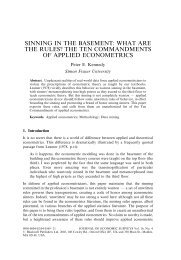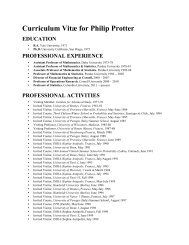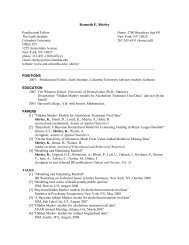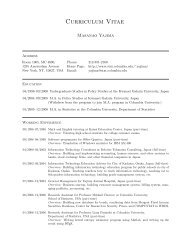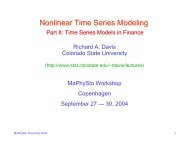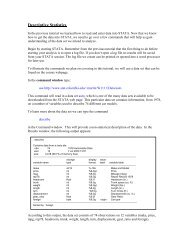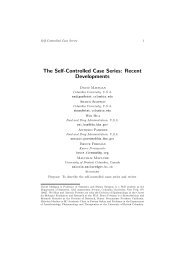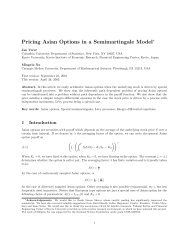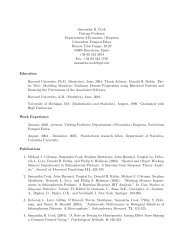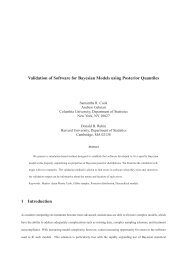Solution to selected problems.
Solution to selected problems.
Solution to selected problems.
Create successful ePaper yourself
Turn your PDF publications into a flip-book with our unique Google optimized e-Paper software.
20. Let {T n } be an increasing sequence of s<strong>to</strong>pping times such that X Tn is a special semimartingale<br />
as shown in the statement. Then by theorem 37, Xt∧T ∗ n<br />
= sup s≤t |X T n<br />
s | is locally integrable.<br />
Namely, there exists an increasing sequence of s<strong>to</strong>pping times {R n } such that (Xt∧T ∗ n<br />
) R n<br />
is integrable.<br />
Let S n = T n ∧ R n . Then S n is an increasing sequence of s<strong>to</strong>pping times such that (Xt ∗ ) Sn<br />
is integrable. Then Xt<br />
∗ is locally integrable and by theorem 37, X is a special semimartingale.<br />
21. Since Q ∼ P, dQ/dP > 0 and Z > 0. Clearly M ∈ L 1 (Q) if and only if MZ ∈ L 1 (P). By<br />
generalized Bayes’ formula.<br />
E Q [M t |F s ] = E P[M t Z t |F s ]<br />
E P [Z t |F s ]<br />
Thus E P [M t Z t |F s ] = M s Z s if and only if E Q [M t |F s ] = M s .<br />
= E P[M t Z t |F s ]<br />
Z s<br />
, t ≥ s (57)<br />
22. By Rao’s theorem. X has a unique decomposition X = M + A where M is (G, P)-local<br />
martingale and A is a predictable process with path of locally integrable variation. E[X ti+1 −<br />
X ti |G ti ] = E[A ti+1 − A ti |G ti ]. So<br />
[ n∑<br />
]<br />
sup E |E[A ti − A ti +1|G ti ]| < ∞ (58)<br />
τ<br />
i=0<br />
Y t = E[X t |F t ] = E[M t |F t ] + E[A t |F t ]. Since E[E[M t |F t ]|F s ] = E[M t |F s ] = E[E[M t |G s ]|F s ]] =<br />
E[M s | fil s ], E[M t |F t ] is a martingale. Therefore<br />
[ n∑<br />
]<br />
n∑<br />
Var τ (Y ) = E |E[E[A ti |F ti ] − E[A ti +1|F ti +1]|F ti ]| = E [|E[A ti − A ti +1|F ti ]|] (59)<br />
i=1<br />
i=1<br />
For arbitrary σ-algebra F, G such that F ⊂ G and X ∈ L 1 ,<br />
E (|E[X|F]|) = E (|E (E[X|G]|F) |) ≤ E (E (|E[X|G]||F)) = E (|E[X|G]|) (60)<br />
Thus for every τ and t i , E [|E[A ti − A ti +1|F ti ]|] ≤ E [|E[A ti − A ti +1|G ti ]|]. Therefore Var(X) < ∞<br />
(w.r.t. {G t })implies Var(Y) < ∞ (w.r.t {F t }) and Y is ({F t }, P)-quasi-martingale.<br />
23. We introduce a following standard result without proof.<br />
Lemma. Let N be a local martingale. If E([N, N] 1/2<br />
∞ ) < ∞ or alternatively, N ∈ H 1 then<br />
N is uniformly integrable martingale.<br />
This is a direct consequence of Fefferman’s inequality. (Theorem 52 in chapter 4. See chapter 4<br />
section 4 for the definition of H 1 and related <strong>to</strong>pics.) We also take a liberty <strong>to</strong> assume Burkholder-<br />
Davis-Gundy inequality (theorem 48 in chapter 4) in the following discussion.<br />
Once we accept this lemma, it suffices <strong>to</strong> show that a local martingale [A, M] ∈ H 1 . By Kunita-<br />
Watanabe inequality, [A, M] 1/2<br />
∞ ≤ [A, A] 1/4<br />
∞ [M, M] 1/4<br />
∞ . Then by Hölder inequality,<br />
( )<br />
E [A, M] 1/2<br />
∞<br />
(<br />
≤ E<br />
[A, A] 1/2<br />
∞<br />
) 1 (<br />
2<br />
E<br />
[M, M] 1/2<br />
∞<br />
23<br />
)<br />
. (61)



